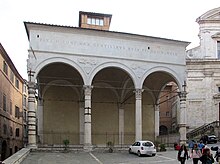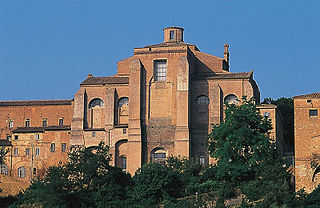
Sant'Agostino is a Roman Catholic church in Siena, region of Tuscany, Italy.

San Martino is a Roman Catholic church located on Via del Porrione, in the Terzo San Martino in central in Siena, region of Tuscany, Italy. Adjacent to the church is the Renaissance style Logge del Papa erected in 1462 by commission by Pope Pius II Piccolomini.
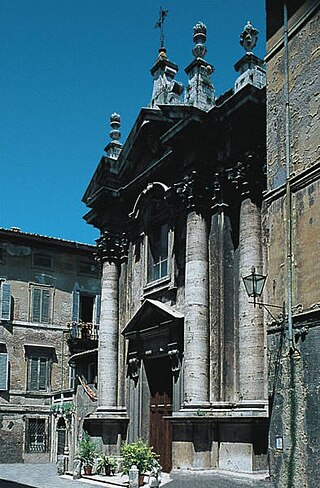
San Giorgio is a Baroque style, Roman Catholic church located on Via di Pantaneto #113 in the Terzo San Martino of the city of Siena, region of Tuscany, Italy.
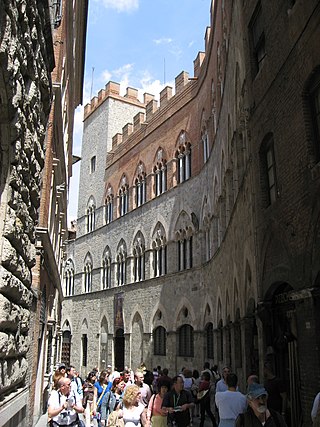
The Palazzo Chigi-Saracini is a Gothic urban palace on the Via di Città in the Terzo di Città in central Siena, Tuscany, Italy. It is the seat of the Accademia Musicale Chigiana.

The Corteo Storico is a historical costume parade in Siena, Tuscany, Italy. It takes place before the famous horse race known as the Palio on the 2nd of July and on August 16, each year.

The Pinacoteca Nazionale is a national museum in Siena, Tuscany, Italy. Inaugurated in 1932, it houses especially late medieval and Renaissance paintings from Italian artists. It is housed in the Brigidi and Buonsignori palaces in the city's center: the former, built in the 14th century, it is traditionally identified as the Pannocchieschi family's residence. The Palazzo Bichi-Buonsignori, built in the 15th century, was until recently thought to have a 19th-century neo-medieval façade based on the city's Palazzo Pubblico; however, restoration in 2022 revealed that it is mostly original.
The following is a timeline of the history of the city of Siena, Tuscany, Italy.

The Porta Tufi or Tufi Gate is one of the remaining portals in the medieval Walls of Siena. It is located on Strada di Tufi, now Via Pier Andrea Mattioli, in Siena, region of Tuscany, Italy. It stands on a peninsula of walls near Sant'Agostino, opening to a road leading south of the city.

Porta Romana is one of the portals in the medieval Walls of Siena. It is located on Via Cassia in Siena, region of Tuscany, Italy. The gate exits near the Basilica of San Clemente and leads south out of town to Via Enea Silvio Piccolomini.

The Palazzo Spannocchi is a Renaissance style urban palace located on the Piazza Salimbeni, just off Via Banchi di Sopra in the Terzo di Camollia of the city of Siena, region of Tuscany, Italy. The building was associated with an ancient mercantile family of Siena.

Santa Maria in Provenzano, or the Insigne Collegiata di Santa Maria in Provenzano, is a late-Renaissance-Baroque style, Roman Catholic, collegiate church in Piazza Provenzano Salvani, in the Terza Camollia, just southwest of the basilica of San Francesco, in the city of Siena, region of Tuscany, Italy. This Marian shrine was built around a 14th-century terracotta icon of the Madonna, which was credited with miracles. The Palio of Siena takes place on the day of veneration of this Marian devotion.

The Palazzo Piccolomini, also known as the Palazzo Todeschini Piccolomini is a Renaissance-style palace in the city of Siena, region of Tuscany, Italy. It is located on the Banchi di Sotto, at the corner with Via Rinaldini; uphill and west of the church of San Martino, the Loggia del Papa, and the Palazzo delle Papesse, which also built by a Piccolomini family member.
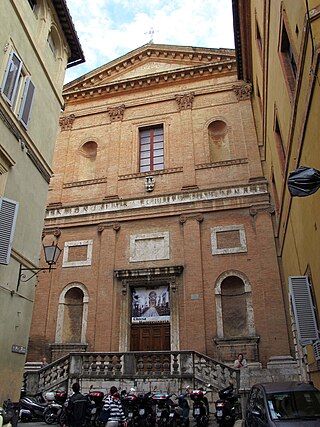
San Vigilio is a Renaissance and Baroque style, Roman Catholic church located on Via San Vigilio, Siena, region of Tuscany, Italy. The exterior has a sober classical facade, while the interior has rich Baroque decorations. The church is dedicated to the Bishop and martyr St Vigilius; it now serves as the chapel for the University of Siena. It stands across the street from the Castellare Ugurgieri, and down the street from the Palazzo Bandini Piccolomini found on the junction with Via Sallustio Bandini.
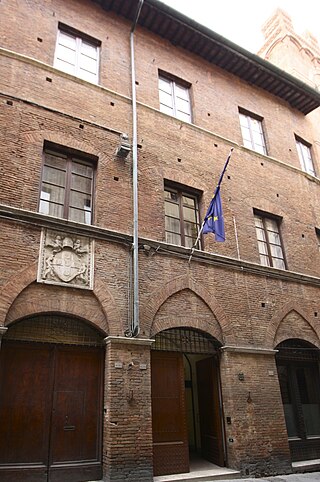
The Palazzo Marsili Libelli is a Gothic style urban palace localized on Via di Città #136-142, in the Terzo di Città, in the city of Siena, region of Tuscany, Italy. The palace is adjacent to the taller Palazzo Marsili with a crenellated roofline and mullioned second and third story windows, and which stands at the corner of Via di Città and Via del Castoro.

The Palazzo Arcivescovile or Archbishop's Palace of Siena is the official residence of the archbishop and the offices of the Archdiocese of Siena-Colle di Val d'Elsa-Montalcino. The neo-Gothic architecture building is located adjacent to the Cathedral of Siena.

The Palazzo Bandini-Piccolomini is a Renaissance style urban palace located on via Sallustio Bandini #32, corner Via San Vigilio in the city of Siena, region of Tuscany. It is across the street from the rear facade of the Castellare degli Ugurghieri. The palace was constructed circa 1460, and the design has been attributed to Cecco di Giorgio. The priest and proto-economist Sallustio Bandini was born in the house. The facade is mainly brick. The portal and window mouldings are made of grey pietra serena and has a Piccolomini shield with 5 crescent moons. The portal also has images of children astride dolphins. The second story windows have triangular pediments. The small interior courtyard has a well. The iron rings on the facade were formerly used to tie up horses. The property is owned by the University of Siena.

The Fountain of San Maurizio, also called Samoreci, is a medieval public fountain located at the intersection of Via di Pantaneto and Via San Girolamo in Siena, region of Tuscany, Italy. It is located just outside one set of medieval city walls and the Arco di San Maurizio.
La Fontana di Pantaneto, now known as the Fontana del Leocorno is a public monumental fountain located on Via Pantaneto in Siena, region of Tuscany, Italy. The fountain is located across from Via Pantaneto #19.

The Palazzo Piccolomini-Clementini is a Gothic-style palace located on Via Banchi di Sotto #75 in the city of Siena, region of Tuscany, Italy. It is located across the street from the more imposing Renaissance-style Palazzo Piccolomini and the Loggia del Papa. The nearby Palazzo delle Papesse was also built by a Piccolomini family member.
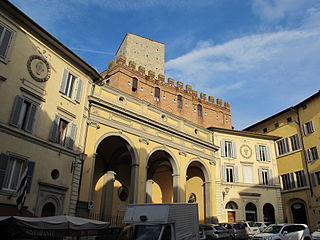
The Piazza or Piazzetta dell'Indipendenza is located just north of Piazza del Campo in the Terzo di Camollia in the city of Siena, region of Tuscany, Italy. It is located centrally at the intersection of Via delle Terme and dei Termini, about two blocks Northwest of the Piazza del Campo.
